In this article, we’ll explore AI tools for business. What are the best instruments for handling routine tasks, saving time, and increasing productivity? And how do they work?
What are AI tools for business?
AI tools are software programs that utilizes the power of artificial intelligence to address particular business problems. These products employ AI algorithms and vast datasets to automate, optimize, and enhance various processes across diverse industries.
AI tools can be simple applications handling repetitive routine tasks or complex platforms supporting advanced machine learning and data analysis. They help transform operations, streamline workflows, and provide valuable insights, making them indispensable in today's data-driven world.
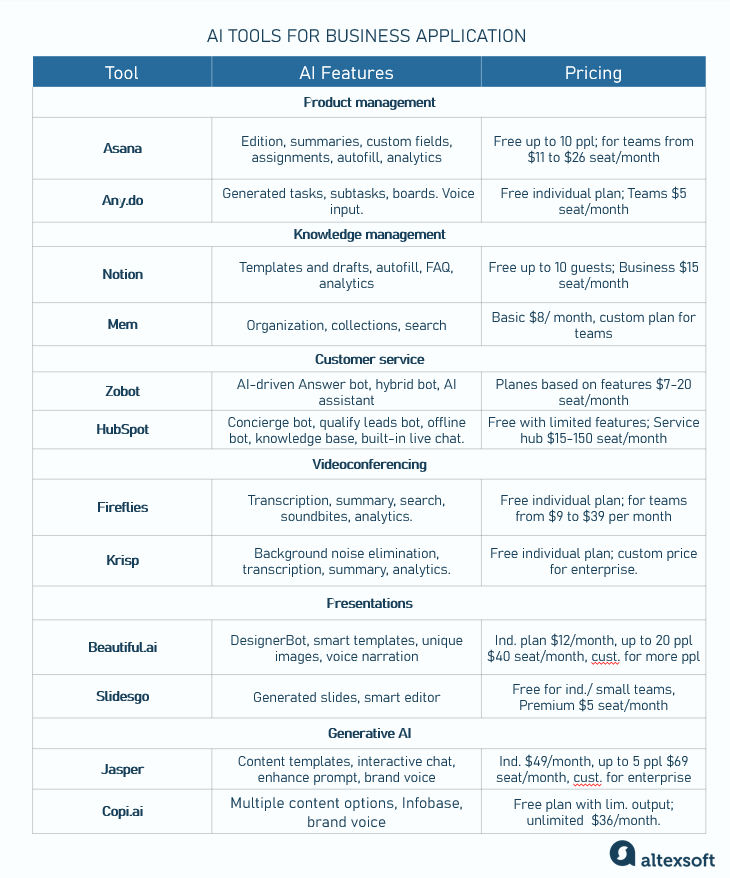
AI tools for business applications
AI tools for task tracking and project management
In the realm of project management, stalwart tools like Trello and Jira have long been trusted companions.
Read our article comparing the best traditional tools for project management, including Trello, Jira, Basecamp, Smartshit, and more.
However, as technology advances by leaps and bounds, the landscape is rapidly evolving with the integration of artificial intelligence. AI-driven PM tools are significantly improving project managers' operations. AI automates scheduling by analyzing project data and predicting timelines, significantly reducing manual effort. AI features can identify potential bottlenecks and suggest resource reallocations to keep projects on track.
Gartner predicted that AI would do 80 percent of project management tasks in 2030, so PMs will be able to focus on strategic planning and communicating with stakeholders. For now, the top-3 industries using AI in PM solutions are:
- Finance and bank sector
- Government organizations and defense
- IT and telecom
If you don't want to miss the boat, it's time to get on board.
Asana: a flexible tool for seamless team collaboration
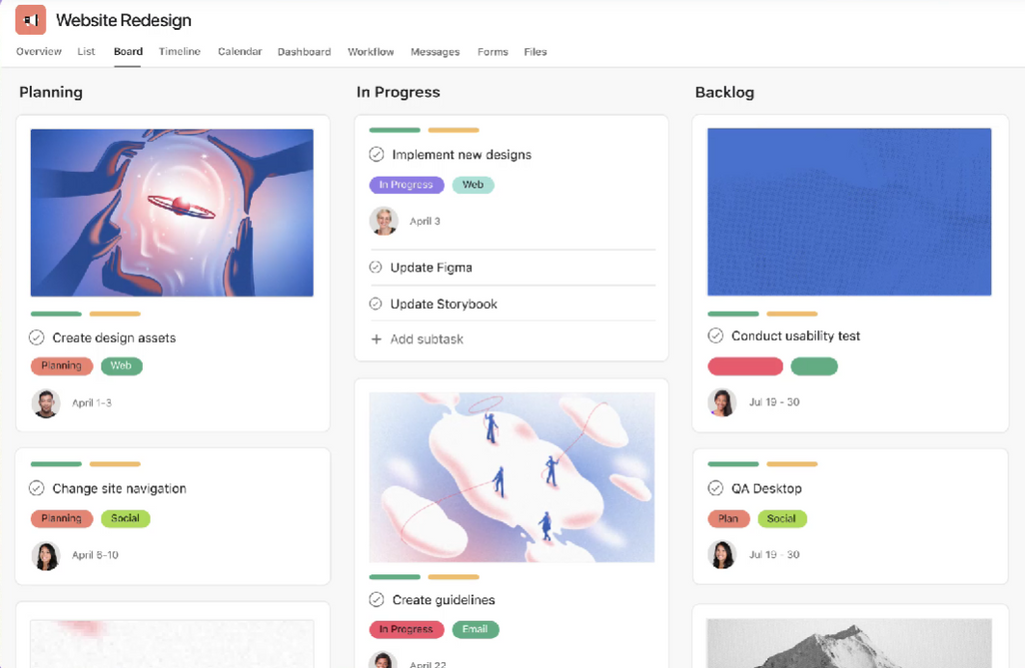
Asana excels at handling particular processes and lightweight projects. Source: Asana
Asana is a flexible work management tool for tracking a team's tasks. It assigns responsibilities, sets due dates, and organizes related information. Users can customize their workflow or use Asana’s versatile templates for various needs: checklists, meeting agendas, task creation, and more.
Unlike traditional project management software designed for complex, project-based workflows, Asana excels at handling certain processes and lightweight projects. However, in this capacity, as an additional tool, it is also popular across large organizations and businesses like NASA, Spotify, and Deloitte.
Asana employs AI to edit, generate summaries, and suggest custom fields based on tasks and other content in a project. AI also proposes task assignments and deadlines based on past data. It enhances collaboration by showing team members relevant to the discussed topic so you can tag them in the chat. Asana’s AI-driven reporting and analytics provide insights into team performance.
From streamlined task tracking to publishing release notes for hundreds of tickets in seconds, read our article on AI for project management to learn how AI can help you with these and other tasks. Also, discover insights from Eugene Ovdiyuk, a project manager at AltexSoft.
Pros:
- User-friendly modern design
- Customizable workflows and templates
- Strong collaboration features
- Supports the Model Context Protocol (MCP), allowing AI agents to access its platform
Cons:
- Limited functionality for complex projects
- No AI features in the free plan
Pricing. There’s a free personal plan for up to 10 teammates. The free version is limited and comes without AI, but it can give you a sense of what the product looks like. The “Starter” plan for growing teams is $11 per user per month. The “Advanced” plan for companies that need to manage tasks across multiple departments is $26 per user per month. Asana also offers 50 percent off for nonprofits.
Any.do: an intuitive productivity tool for smaller teams
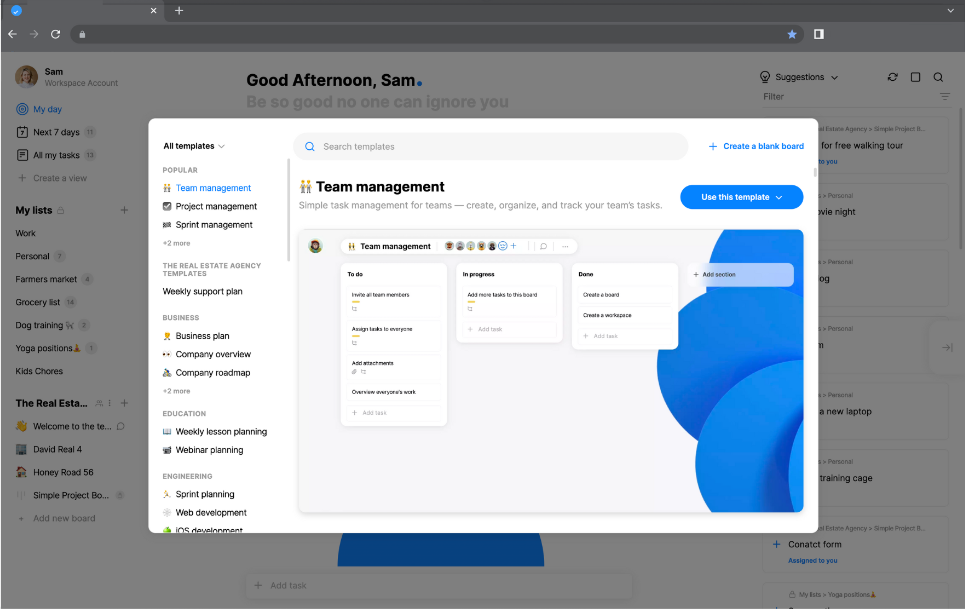
That’s what board templates look like. Source: Any.do
Any.do is a productivity tool designed initially for individual and family use, but it can also enhance team collaboration and task management.
Key features include task management, shared lists and projects, and smart suggestions. The AI can generate tasks, subtasks, boards, and checklists. For example, to generate a workspace board, just write a short description of your project and choose how to organize it: by deadline, progress, status, etc. When creating a task list, you can click the “Suggest” button to add items you may have missed.
Users can activate voice input by granting Any.do access to the mobile device's speech recognition capabilities. Additionally, personal users can take advantage of Any.do's integration with Siri and Apple Reminders for a voice-assisted experience.
Pros:
- Intuitive and user-friendly interface
- Seamless integration with calendars and reminders
- Available on any device, including smartwatches
Cons:
- Limited features for complex project management
- Sync issues across multiple devices
- No AI features in the free plan
Pricing: The personal free plan includes basic features: lists, calendars, and reminders. The “Premium” plan for $3 per month is actually also for personal use but includes AI features. The “Teams” plan is $5 per month per member. It allows sharing workspaces and provides workflow templates, unlimited project boards, and admin tools.
AI tools for knowledge management
These platforms gather all your information in one place, so you spend less time hunting for documents and more time getting things done. Keeping all corporate wisdom in one storage allows teams to find answers without bothering colleagues. For example, you can check the initial business requirements and how they have changed during the project at any time.
AI instruments also help capture and document implicit knowledge and insights often lost and forgotten after another action-packed daily meeting.
Plus, AI tools for knowledge management support both real-time and asynchronous collaboration, so everyone can contribute easily, whether your team is scattered across the globe or working from home.
Notion: an all-in-one repository of corporate wisdom
Notion is an all-in-one, highly customizable workspace designed for team collaboration. Core features include notes, documents, databases, task tracking, and collaboration tools. Powerful filters allow users to locate data quickly across teams. Customizable notifications ensure that all interested parties always see editing, mentions, and comments. AI features mainly involve content creation and analytics.
For example, AI generates templates and drafts for any type of content, from emails to video scripts, and it also translates and proposes how to edit voice and tone based on all the information you shared with the app.

Notion ihighly customizable workspace designed for team collaboration.Source: Notion
AI autofill runs through hundreds of docs in minutes, then writes up insights, summaries, and suggests steps to get the planned tasks done.
The AI Q&A feature immediately answers any question related to your work using information from your databases, projects, and docs. You can ask, for example, “What’s the web team focusing on this week?” and get the report.
Besides AI features, Notion is a very convenient and adaptable tool. The little joys in life are essential, you know. Collapsible sections keep your technical documentation easy to read, and code snippets include native syntax highlighting for dozens of programming languages. The synced blocks feature ensures content updates automatically across multiple locations. Every page serves as the entrance to the rabbit hole since any documents can be linked by typing "@."
Pros:
- Unlimited free storage and file upload for most plans
- Integrations with nearly 100 apps and services, including Slack, GitHub, Asana, Figma, and Jira, to share info in one click
- Endlessly customizable
Cons:
- Overly complex for many users
- No offline access
Pricing: The free plan allows up to 10 guests (clients who can only read), a collaborative workspace, and basic page analytics. The “Plus” plan, which is $10 per person per month, offers unlimited file uploads, blocks, up to 100 guests, and a 30-day page history. “Business”, for $15 per person per month, means advanced analytics, up to 250 guests, and a 90-day page history.
Mem: an intuitive app for anyone who thinks on the go
Mem is another tool for organizing notes for convenient collaboration. However, it is primarily intended for individual use by entrepreneurs, specialists, researchers, etc. Mem is positioned as a “magic notepad” for anyone who thinks on the go and needs to take notes on the fly.
It doesn’t offer many customizable options because it primarily focuses on AI-powered organization features. The app excels at instantly saving notes, web pages, and thoughts, automatically organizing them based on context. For example, it recommends creating specific thematic collections like “Customer calls,” “Onboarding,” “Home renovation,” etc. This removes the need for manual tagging and helps uncover connections you might have missed. You can view related notes side by side, making it easier to see the bigger picture.
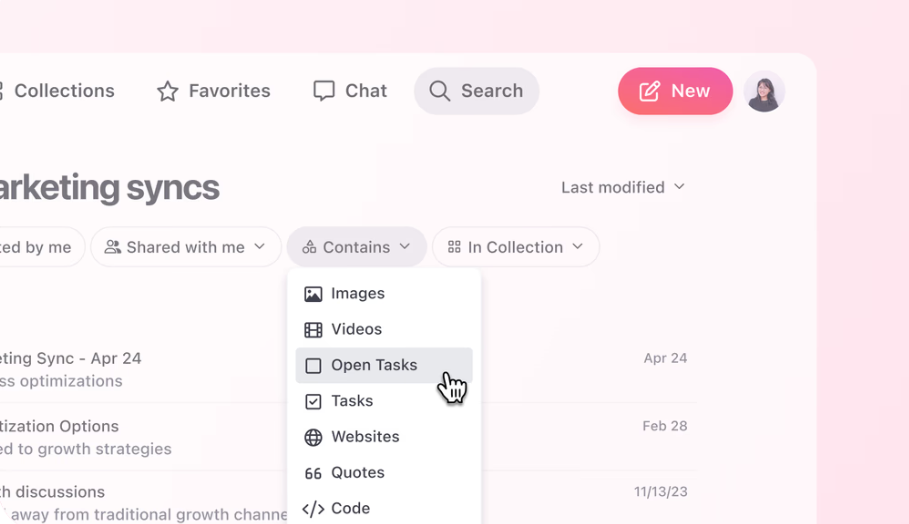
Mem has a very intuitive designe. Source: Mem
The AI search is highly intuitive and fast. You can search using filters like “Shared by me,” “Contains open tasks,” “Contains video,” and “Last modified on …” It's almost to the point where you could ask the AI assistant, “Where did I put my wallet?”
Pros:
- Minimalistic, intuitive design
- Native iOS app
Cons:
- Limited features
- No free plan
Pricing: an individual basic plan for $8.33 per month includes unlimited storage and advanced features; Mem also offers tailored solutions for teams.
AI tools for customer service
Natural language processing allows AI tools like chatbots and voice bots to offer quick help through human-like conversations. Chatbots have found wide applications, particularly in the hospitality industry. Branded hotel chains like Mariott, Hyatt, and Intercontinental have chatbots explicitly developed to meet business needs.
For example, Hilton Hotels uses an AI-powered chatbot to manage reservations and guest inquiries. The Hiltonbot handles tasks such as booking confirmations, cancellations, and modifications accurately, reducing the risk of overbooking. Additionally, AI-driven systems can analyze guest preferences and predict future bookings, allowing for better resource management and personalized experiences.
Since launching in 2016, Hiltonbot has engaged in over 10 million conversations, reducing average customer service wait times by 30 percent. It operates 24/7 and supports over 20 languages, and people using Hiltonbot are more likely to describe their experience as "excellent" all around.
Business owners considering implementing a chatbot could start with ready-made tools.
HubSpot: free multifunctional chatbot builder
HubSpot is a widely used CRM platform that includes marketing, sales, service, operations, website-building, and chatbot software. It provides tools to manage and analyze customer interactions and data throughout the customer lifecycle.
The no-code AI chatbot builder is a HubSpot’ standout feature. You can start with a basic free chatbot and later add more advanced functions.
The free plan lets users built task-specific bots that guide visitors through pre-set questions. These are so called rule-based bots, which means they don't adapt to the conversation. Free, pre-built options include
- a live chat that connects visitors with live agents based on availability,
- a qualify leads bot that asks qualifying questions before passing visitors to a live agent,
- a meetings bot that schedules meetings for specific purposes, and
- a tickets bot that gathers customer queries and creates support tickets for follow-up.
With the Service Hub Professional upgrade, you get more sophisticated bots.
- Knowledge base + live chat offers customers a choice between looking for answers in a knowledge base via a knowledge-aware chatbot or switching to a live agent.
- Concierge bot offers customers options to speak to someone or perform tasks.
- Knowledge base + support bot uses conversational AI for support without live agents.
These advanced bots use a knowledge base to provide human-like responses, making them more adaptable and effective replacements for live agents. The messages are personalized thanks to using customer information pulled from the CRM.
Pros:
- Integration with powerful HubSpot CRM
- Unlimited custom fields and tags
- Multiple features
Cons:
- Expensive pricing for advanced AI features
- Chatbots deployable on FB Messenger and your website only
- No live translate feature
- Limited templates
Pricing: free plan with limited features, Service Hub plan costs $15-150 per user per month.
Zobot: intuitive drag-and-drop chatbot builder

Yobot builds conversational flow. Source: Zoho SalesIQ
Another no-code Zobot chatbot builder is a part of a Zoho SalesIQ CRM platform, which, overall, offers fewer advanced features compared to the HubSpot platform but is more cost-effective. To access a chatbot builder you have to be subscribed to the Zoho SalesIQ CRM.
Zobot provides two chatbot options.
- The AI-driven Answer bot leverages your knowledge base to understand and respond to common customer queries using natural language processing (NLP). It can be customized for any industry, with a variety of industry-specific templates available.
- Zobot with AI capabilities is a hybrid bot: rule-based with integrated AI features. This combination allows the chatbot to follow predefined workflows while also understanding and responding to more complex queries using AI, offering a more dynamic and responsive customer support experience.
Both can schedule appointments and escalate a conversation to the live agent when needed.
Zobots can be customized for use in any industry with ease. By providing the appropriate conversation structure and flow, a Zobot can be trained to adapt to different fields or sectors. A variety of industry- and functionality-specific templates are available in the gallery.
In addition to chatbots, Zoho offers Zia, a virtual assistant that supports both customers and agents. Zia helps agents craft professional replies, access up-to-date customer account information, and suggest relevant tags for notes. For customer support, Zia handles frequently asked questions.
Pros:
- Intuitive drag-and-drop chatbot builder interface
- Deployable on all popular messengers like Facebook Messenger, Instagram, WhatsApp, WeChat, and Telegram
- Live translation in 30 languages ( “Enterprise” plan)
Cons:
- No chatbot builder in a free plan
- Continuous training can be resource-intensive
Pricing: Plans that include chatbot builders vary from $7 (1 chatbot) to $20 (10 chstbots) per user per month. Apart from that features include all messaging channels, FAQ answer bot, group chat, built-in translation, real time analytics and more.
If you want to learn more about how advanced chatbots work, read our article about conversational AI.
AI tools for meetings
Videoconferencing became a thing during the COVID-19 pandemic. Between December 2019 and March 2020, the number of daily Zoom users increased 20-fold, reaching 200 million. That was when the Oxford English Dictionary named “Zoom” a word of the year.
Although many companies brought employees back to the office after the pandemic, videoconferencing solutions remain essential for team communication. Meeting platforms now feature live chat, file sharing, and digital whiteboards. Additionally, thanks to AI advancements, we have very helpful tools that can capture video in real time, transcribe, and translate automatically.
Fireflies: a multifunctional tool for videocall optimization
Fireflies is an AI-powered app for optimizing meetings by transcribing and analyzing voice conversations. It integrates easily with popular video conferencing and cloud storage platforms such as Zoom, Microsoft Teams, and Google Drive and can connect to other applications via API.
Key features include AI transcription, summarization, and conversation intelligence. The software automatically transcribes speech into text and generates concise summaries of meetings, highlighting key points and decisions so that you don’t have to review long recordings.
Users can search transcripts by keywords, themes, topics, or specific questions, allowing them to quickly retrieve relevant info from past conversations.
Read our dedicated article on AI-driven software development to learn how stakeholders are using the AI functionality of tools like Fireflies to streamline their meetings.
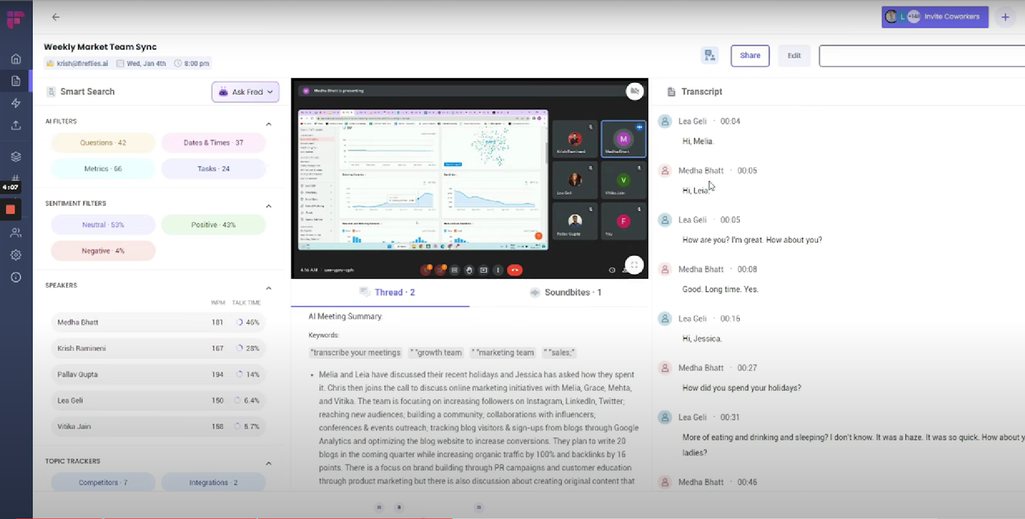
AI app for optimizing meetings by transcribing and analyzing voice conversations. Source: Fireflies
Another handy feature is soundbites. If there's an important piece of information in the transcript, you can highlight it to create a short sound clip. You can then share this clip with teammates so they don’t have to sift through the entire call to hear it.
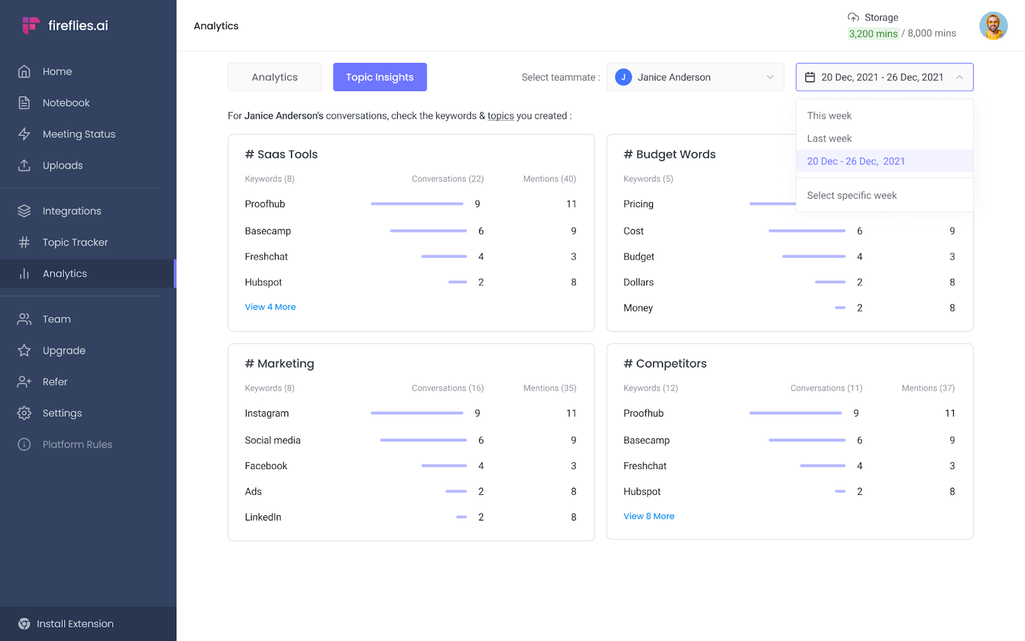
Source: Fireflies
Last but not least, the Fireflies conversation intelligence suite consolidates insights into main topics, sentiments, and team members’ participation.
Pros:
- Accurate AI transcription (the company claims to have 90 percent accuracy for most types of meetings) in about 70 languages
- Searchable meeting transcripts
- Available as a mobile app
Cons:
- No translation feature
- Slow transcription for long calls
- Failures in the recordings when an internet connection isn’t perfect
- Searching for transcripts can be complicated
- No AI features in the free plan
Pricing: The free individual plan offers basic features and limited integration. The “Pro” for small teams is $9 per month, the “Business” for growing teams is $19 per month, and the “Enterprise” for larger companies is $39 per month. The latter includes an onboarding program, a dedicated account manager, and dedicated support.
Krisp: an app that helps you be heard
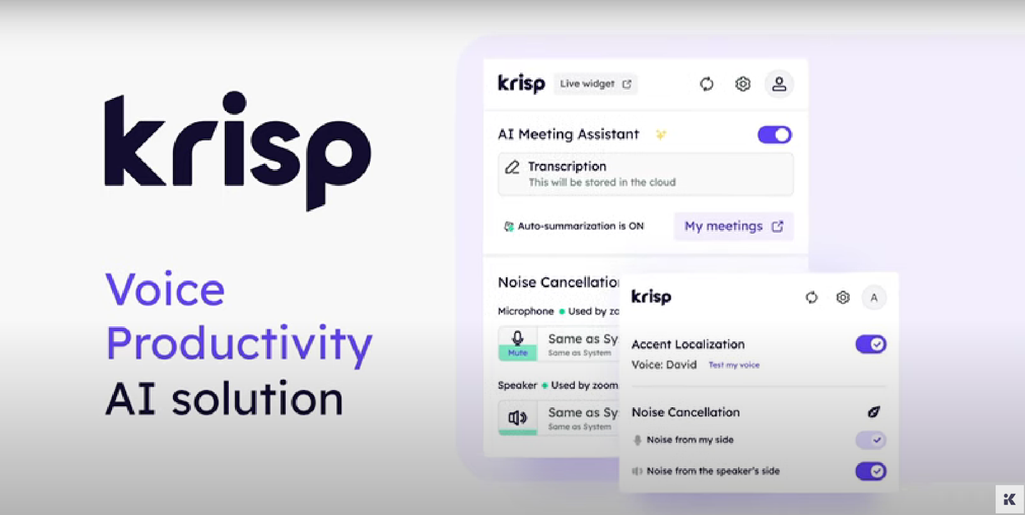
Source: Krisp
Krisp is an AI-powered noise-canceling tool designed to improve audio quality during calls and meetings. When you install the Krisp app on your computer, it creates virtual devices, namely a microphone and speaker, that mimic hardware. Then, users can select Krisp Microphone and Speaker as the preferred audio input and output methods.
The app effectively eliminates any background noise for both the speaker and listener, including keyboard clicks, dog barks, construction noise in the street, and other disruptive sounds. It ensures distraction-free communication. Voice quality enhancement features ensure the audio remains crisp and clear after the background elimination.
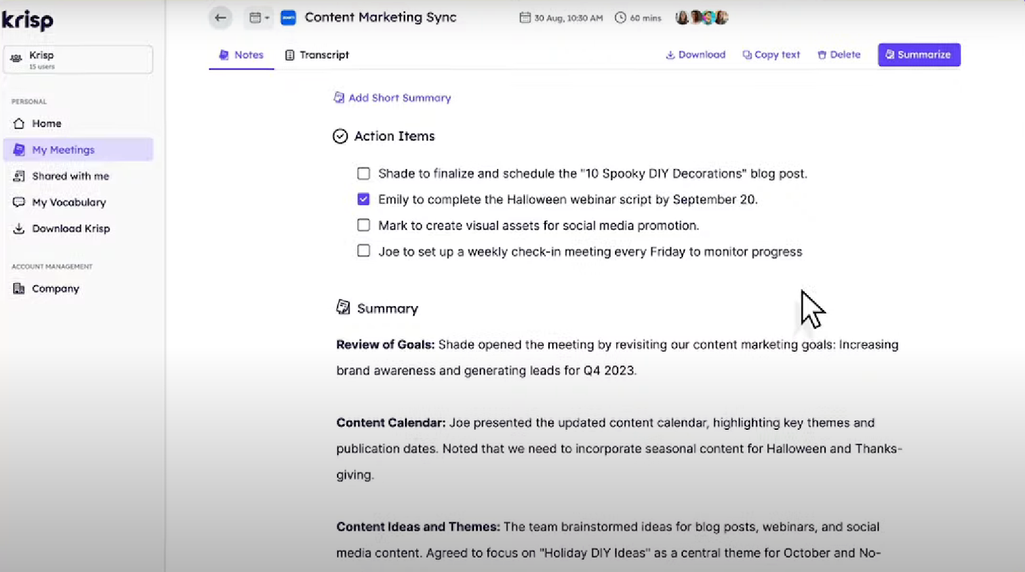
AI-powered noise-canceling tool designed to improve audio quality during calls and meetings. Source: Krisp
Apart from the main features, the product provides transcriptions (10+ languages), summarizing, meeting notes, and recording.
Pros:
- Significant reduction in background noise
- User-friendly interface with minimal setup required
Cons:
- Free plan limited to 60 minutes daily
- Occasional distortions of voice quality because of noise cancellation
Pricing: The free plan provides basic features for personal use, limited to 60 minutes daily. The “Pro” plan ($8/month) allows unlimited basic features plus multi-language support. The call center and enterprise plan offer varying prices based on volume and terms. These may include more advanced tools such as AI accent localization and acoustic and room echo cancellation.
AI tools for presentations
A professional presentation is the second most powerful tool for convincing investors or potential customers, right after your charisma. However, designing a professional presentation from scratch can be time-consuming and challenging.
Fortunately, AI presentation makers can create slide decks in minutes. This software uses generative AI to help users quickly design, edit, and format presentations. It lets you focus on delivering your message rather than spending an evening on the visual details.
Beautiful.ai: first presentation maker with design AI
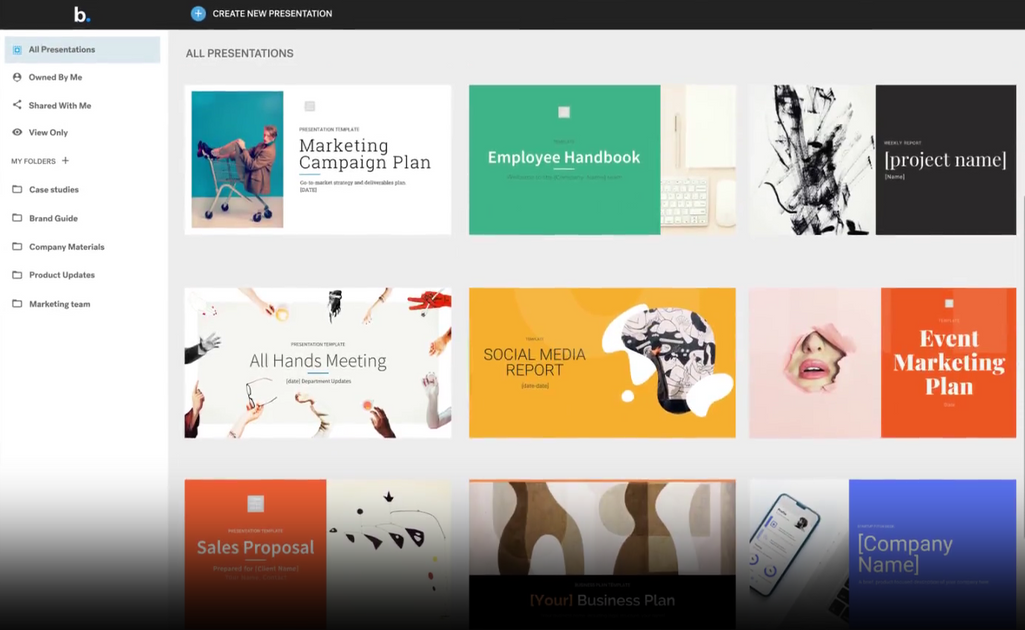
Users can search for slide templates or layouts in the inspiration gallery. Source: Beautiful.ai
Beautiful.ai is the first presentation maker with design AI (at least that’s what the site claims). The tool features DesignerBot, an AI assistant that helps users create presentations effortlessly, even if they’re unsure where to start. Type a detailed description of the presentation topic, and DesignerBot will generate the first draft. Then, you can use smart slide templates for quick edits and refine the draft to match the desired style. There’s no need to spend time formatting; just add content, and the slides will adapt.
DesignerBot can also generate unique images based on text descriptions.
The starter templates offer a valuable head start in creating a pitch deck, sales proposal, data report, or marketing plan. The rich media library provides millions of free stock photos, videos, and icons. Users can search for slide templates or layouts in the inspiration gallery to visualize their ideas. Additionally, it’s possible to add voice narration over slides.
The product integrates with Slack, Dropbox, and PowerPoint.
Pros:
- Wide range of templates
- Intuitive interface
- Easy to use and learn
Cons:
- Issues with modifying some templates
- Unhelpful customer support
- No free plan
Pricing. The “Pro” plan for individuals is $12 per month; the “Team” plan for teams up to 20 people is $40 per user per month; and the “Enterprise” plan for 20+ people is custom. Collaboration and shared templates, themes, and libraries are available only for the “Team” (limited) and “Enterprise” (unlimited) plans. There’s also an option to pay $45 for a single presentation.
Slidesgo: free tool integrated with PowerPoint and Google Slides
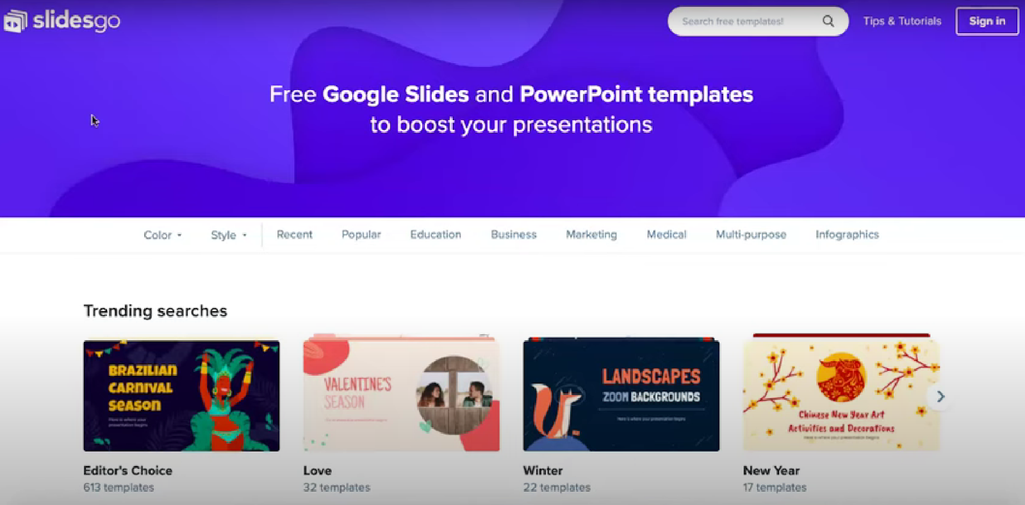
Slidesgo generates slides based on your presentation topic. Source: Slidesgo
The AI presentation maker is a part of the Slidesgo platform, which offers a wide range of visual assets and free templates for various needs. Slidesgo AI generates slides based on your presentation topic. It suggests relevant content, layouts, and graphics. You can also choose tone and style. Seven styles range from “minimalism” to “cute.” Additionally, AI assists with color schemes, fonts, and design elements, taking the guesswork out of creating visually consistent presentations. The online editor allows you to change slides to have them your way.
Once the presentation is ready, you can download it for free in .pdf format and share the link with colleagues.
Pros:
- Accessible from any device
- Integration with Google Slides, PowerPoint, and Freepik
- Free AI-driven features
Cons:
- Many similar themes
- Lags when working with large presentations
- Customer support only via email
Pricing: Slidesgo.ai offers a free plan for individual use and smaller teams. The number of free templates is limited to 5 per month, and you’ll see the ads. The premium plan, designed for large teams, includes unlimited template downloads, no ads, and priority support at $5.50 per month per user.
Generative AI tools
Generative AI produces text, images, video, audio, and code from user prompts. These tools have versatile applications across various departments and businesses of all sizes. Professionals increasingly rely on generative AI for their daily tasks. Here, we’ll focus on the generative AI software that is best for marketing.
Our article on AI-driven software development details how AI code generation tools like Cursor and GitHub Copilot streamline how AI software engineering teams build and test products. Read on to learn more.
Jasper: jack-of-all-trades in marketing
Jasper is ideal for creating marketing content. It will help you with your blogs, captions, video scripts, marketing copies, sales emails, and SEO content. Jasper is powered by a combination of its proprietary and publicly available AI models, including OpenAI's GPTs.
The tool's standout features are content templates and an interactive chat. With over 50 templates designed for various content types, Jasper simplifies the creation process. Many of these templates are tailored to specific needs. For example, the "Explain it to a child" template does exactly what it promises and can be particularly useful for those who tend to create overly intricate sentences.
The chat feature, which includes assistance for creating prompts, makes the tool user-friendly even for beginners. Unlike ChatGPT, Jasper offers an "Enhance prompt” button to help refine your prompts, adding context and improving the quality of the generated content.
The Jasper Campaigns feature enables marketers to orchestrate the whole marketing campaign effortlessly, provide a concise brief, and select the required assets — such as blog posts, landing page copy, press releases, Google text ads, and more. Jasper then generates them in alignment with your brand voice.
Pros:
- Ability to create cohesive, comprehensive brand content
- Plagiarism checking (not included in a basic plan)
Cons:
- Pretty costly, with no free plan
- Cluttered user interface
Pricing: The “Creator” plan, for $49 per month, is for individuals. The “Pro” plan, for $69 per month per user, allows collaboration for up to 5 team members, DIY templates, SEO mode, and marketing campaigns. A free trial week is available for both plans. “Business” custom pricing includes personalized AI features with additional control, security, team training, and tech support.
Copy.ai: smart co-pilot with great community support
Copy.ai works as a co-pilot, generating multiple content options and allowing you to select the most suitable ones. This approach is particularly advantageous for tasks requiring extensive brainstorming and revision, such as copywriting. The platform works with all the latest large language models, including Anthropic Claude-3 and GPT-4. You can choose one of the options yourself or let Copi.ai select well-mixed models.
One particularly useful feature is the brand voice. The platform analyzes a piece of original content and generates all texts for the brand in the same tone of voice. You can always refine it by either incorporating additional content examples or updating the existing ones you've used.
You can also avoid repeatedly entering your brand information by uploading and securely storing it on the platform Infobase. While creating a text, you can simply reference the data via tags.
Pros:
- Multiple content options
- Helpful community of copywriters on the platform who can offer feedback
- A free plan
Cons:
- Prompts limited to 2,000 words per month with a free plan
- Slow output production compared to other AI tools
Pricing: The free plan for individuals is limited to 2000 words daily and uses only ChatGPT 3.5 and Claude 2 models. The “Starter” plan, for $36 per month, allows unlimited generation with all LLMs and gives the private community access. The “Advanced” plan, for $186 per month, will enable you to integrate Copi.ai with your management apps to automate some workflows, such as writing and sending emails.
AI Tools: benefits and pitfalls
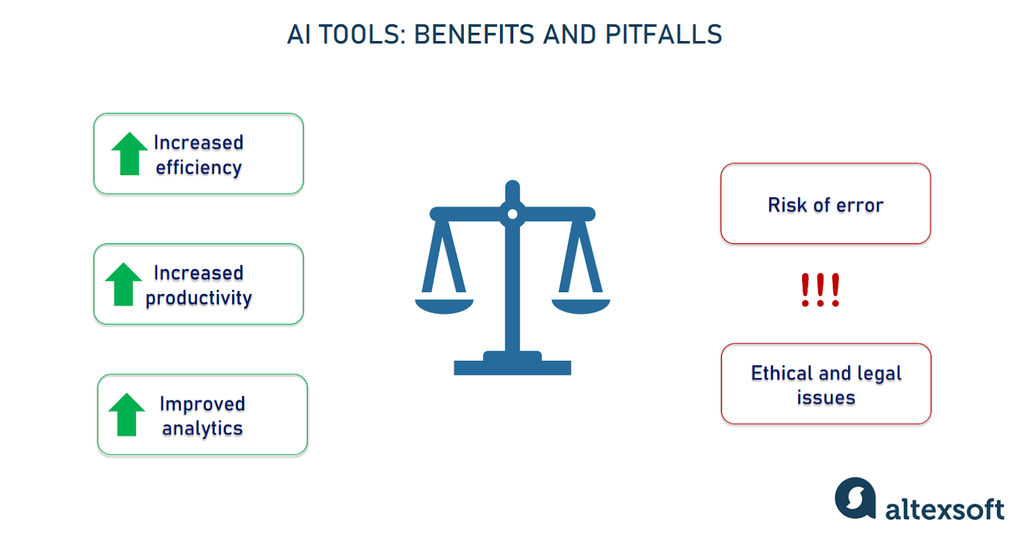
Benefits and pitfalls of AI for businesses
The benefits of AI are pretty obvious. But let's list them once more.
Increased efficiency. The goal of any new technology, AI allows businesses to operate more efficiently. AI automates repetitive tasks, allowing employees to focus on creative and strategic activities.
Increased productivity. Because AI doesn't sleep, eat lunch, feel tired, or get distracted watching a baseball game, it keeps business processes running smoothly 24/7/365. It quickly adapts to new things, and after training, models don't leave for a competitor, tempted by bigger salaries and perks.
Improved analytics and data-driven decisions. AI can quickly process and analyze huge amounts of data, revealing trends that might otherwise go unnoticed.
On the other hand, the hype surrounding AI is no reason to ignore its pitfalls.
Risk of error. When the AI doesn't know the answer to a question, it can fabricate a plausible output, inventing physics formulas or citing non-existent scientific studies. It’s called AI hallucination. One can make a wrong decision based on faulty premises.
Ethical and legal issues. Due to biases that skew original training data or algorithms, AI may unfairly treat certain social groups, for example, in automated resume screening. Another problem is possibly violating a copyright when training generative AI. If you use generative tools, you are potentially at risk of lawsuits.
Read our articles on Explainable AI and Responsible AI to learn more about the challenges AI poses and ways to address them.
So, before integrating AI into your business or its specific facets, you must carefully weigh the advantages and shortcomings. The balance is particularly favorable with ready-made AI tools, which can collectively be referred to as "assistants in daily business routine." These tools save time and effort, improve employees' technical competencies, and always leave the final decisions to individuals, offering choices at every step.
Future of AI tools in the brave new world
As we look toward the future, the landscape of AI generative tools promises to be even more transformative. These advanced systems, capable of executing a wide array of tasks traditionally performed by humans, will only grow more powerful. From crafting sophisticated marketing campaigns to developing innovative software, AI tools will increasingly take on roles that once required human ingenuity.
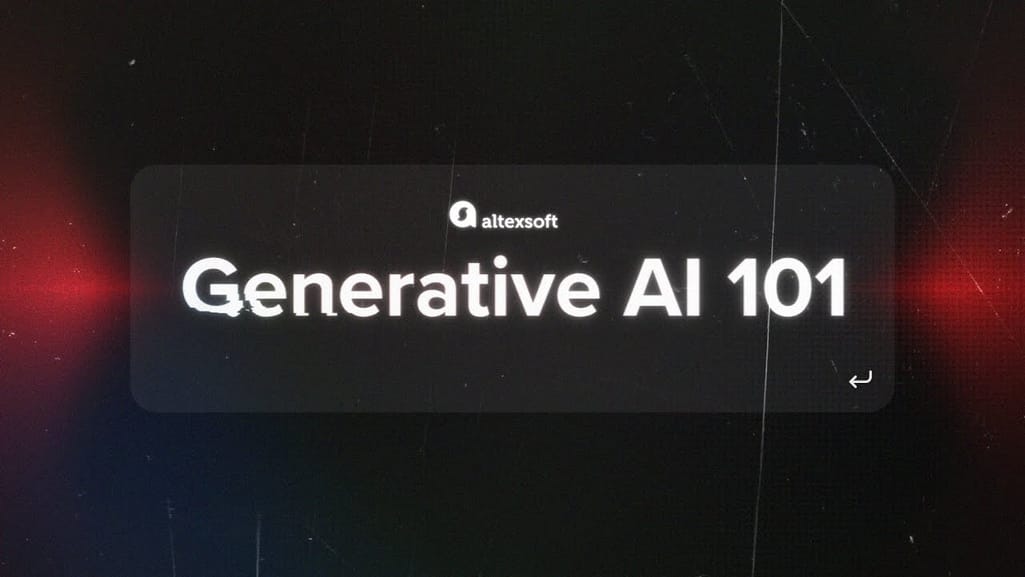

As they evolve, AI's ability to replace human jobs will expand. Fifteen percent of the global workforce, or 400 million workers, risk losing their jobs to AI by 2030. The risk of replacement is highest in the following fields: legal—78 percent; life, physical, and social science—61 percent; office and administrative support—57 percent; and the computer and mathematical sector—53 percent.
However, the brave new world isn't that terrifying. Research from the World Economic Forum suggests that AI could generate approximately 97 million new jobs from 2020 to 2025, offering a potential solution to concerns about workforce displacement.

Olga is a tech journalist at AltexSoft, specializing in travel technologies. With over 25 years of experience in journalism, she began her career writing travel articles for glossy magazines before advancing to editor-in-chief of a specialized media outlet focused on science and travel. Her diverse background also includes roles as a QA specialist and tech writer.
Want to write an article for our blog? Read our requirements and guidelines to become a contributor.

